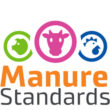The 2,5-year-long project Manure Standards kick-started the development towards more harmonized and equal practices for manure data generation and use in the Baltic Sea Region. The project produced new information on manure, recommendations for good manure utilization, tools for manure mass balance calculation and instructions for representative manure sampling and analysis. The results can be used by farmers, advisors, research and policymakers.
Manure is a valuable resource and its proper handling promotes circular economy. There are always losses related to food and feed production, including all stages of manure management. The risk for emissions is influenced by many factors and not all can be fully controlled. However, with precise nutrient use and manure management the losses can be reduced and the valuable nutrients more effectively utilized.
Improvements with best methods and more information
Manure Standards project developed both manure sampling and analysis, and manure mass balance calculation.
Instructions for manure sampling summarize how, when and where manure samples should be taken to ensure representative sample and subsequent precise analysis. Manure is heterogeneous and a failed sampling can produce either too high or too low nutrient content. Fertilization which is based on incorrect manure nutrient content will be reflected in e.g. crop growth, yield and the risk for nutrient emissions.
An alternative to manure analysis is mass balance calculation following the mass and nutrient flow starting from animal feeding and excretion and proceeding through the practices in housing and manure storage. The project developed two calculation tools: one for farm-level calculation and another for national or regional manure data generation.
In addition to the manure data used in fertilization, efficient manure nutrient use is dependent on all choices made in the manure management chain. The best practices in each stage are described in a handbook titled “How to make the most of manure?”.
Testing the instructions and tools with pilot farms
Manure Standards project cooperated with over 90 pilot farms from all coastal countries around the Baltic Sea. A database containing information of the analyzed manure samples from the farms is available on the project website. Some of the farms were also used when testing the farm-level calculation tool. The experiences received from the cooperation are collected into a report.
The project also calculated national nutrient balances with different methods and compiled a report on legislation and other regulation directing manure use in the Baltic Sea Region. The impact of using precise manure data as the basis of manure use was also assessed from the perspective of the environment and farm economy.
From project results to practical implementation
The project results were used as the basis of Baltic Marine Environment Protection Commission (HELCOM) recommendation on the use of national manure standards. The document gives recommendations for generating and maintaining updated, precise manure data and it has been accepted as part of the targets and measures towards ecologically Baltic Sea.
Furthermore, for instance Estonia will implement the calculation tool developed in the project as an accepted method for farm-level manure data generation and Sweden will use the information produced in developing their existing mass balance calculation system. Finland concluded that its manure data generation methods are in line with the project recommendations, but resources to ensure its maintenance need to be developed and ensured.
All Manure Standards materials and publications are available on the project website. Most of the materials are published in English, but some have also been translated to national languages.
Manure Standards (10/2017–12/2019) was a project funded by the Interreg Baltic Sea Region Programme. It was coordinated by Natural Resources Institute Finland (Luke) and included 19 partners from all nine coastal countries of the Baltic Sea.
Recommendations for generating, maintaining and use of high quality manure data by Manure Standards project
The full recommendations are available here. |
